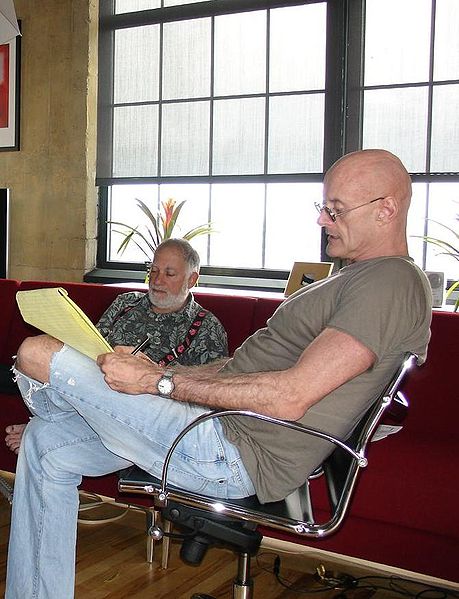回答网友“未来之光”:上世纪九十年代,我介绍过这位思想者(用他们自己的语言就是“精神探索者”),他的名字:Ken Wilber,有许多文集,影响了许多思想者,包括我。以致,从海外回国的行李箱的宝贵空间里,我专门带了他的一本文集。我多次介绍他的看法——在关于梦的研究、东方冥想方法、以及唯识哲学等方面。不论如何,下面是他的照片,可能是近照,但他是居住在大森林里面的:
 他有瑜伽师的证书,我记得是“五级”,很高了。
他有瑜伽师的证书,我记得是“五级”,很高了。
Ken Wilber was born on January 31, 1949 in Oklahoma City, Oklahoma. In 1967, he enrolled as a pre-med student at Duke University, and almost immediately experienced a disillusionment with what science had to offer. He became inspired, like many thousands of others of that generation, by Eastern literature, particularly the Tao Te Ching. He left Duke, enrolled in the University of Nebraska at Omaha, and completed a bachelor's degree with a double major in chemistry and biology.
In 1973, Wilber completed his first book, , and he spent a year giving lectures and workshops before going back to writing. He also helped to launch the journal ReVision in 1978.
In 1982, New Science Library published his anthology The Holographic Paradigm and other Paradoxes a collection of essays and interviews, including one by David Bohm. The essays, including one of his own, looked at how the model of Holography and the Holographic paradigm relate to the fields of consciousness, mysticism and science.
In 1983, Wilber married Terry (Treya) Killam who was shortly thereafter diagnosed with breast cancer. From the fall of 1984 until 1987, Wilber gave up most of his writing to focus on caring for her. Treya died in January 1989; their joint experience was recorded in the 1991 book Grace and Grit.
Subsequently, Wilber wrote Sex, Ecology, Spirituality (SES), (1995), the massive first volume of his Kosmos Trilogy. A Brief History of Everything (1996) was the popularised summary of SES in interview format. The Eye of Spirit (1997) was a compilation of articles he had written for the journal ReVision on the relationship between science and religion. Throughout 1997, he had kept journals of his personal experiences, which were published in 1999 as One Taste, a term for unitary consciousness. Over the next two years his publisher, Shambhala Publications, released eight re-edited volumes of his Collected Works. In 1999, he finished Integral Psychology and wrote . His book, Boomeritis (2002), is a novel which attempts to expose what he perceives as the egotism of a generation born between 1945 and 1964, collectively known as the "Baby Boom Generation", "Baby Boomers" or "Boomers" for the booming number of births that took place during those years.
From 1987, Wilber lived in Boulder, Colorado, where he worked on his Kosmos trilogy and oversaw the work of the Integral Institute. Wilber now lives in Denver, Colorado.
Wilber's holism
A key idea in Wilber's philosophical approach is the holon, which came from the writings of Arthur Koestler. In considering what might be the basic building blocks of existence, he observed that it seems every entity and concept shares a dual nature: as a whole unto itself, and as a part of some other whole. For example, a cell in an organism is a whole and at the same time a part of another whole, the organism.
Another example is that a letter is a self-existing entity and simultaneously an integral part of a word, which then is part of a sentence, which is part of a paragraph, which is part of a page; and so on. Everything from quarks to matter to energy to ideas can be looked at in this way.
In his book Sex, Ecology, Spirituality: The Spirit of Evolution, Wilber outlines approximately twenty tenets that characterize all holons. These tenets form the basis of Wilber's model of manifest reality.
Levels or stages
The concept of levels follows closely on the concept of lines of development. The more highly developed you are in a particular line, the higher level you are at in that line. Wilber's conception of the level is clearly based on several theories of developmental psychology, including: Piaget's theory of cognitive development, Kohlberg's stages of moral development, Maslow's hierarchy of needs, Erikson's stages of psychosocial development, and Jane Loevinger's stages of ego development.
One such scheme describes the ethical developmental line, for example:
- Egocentric (similar to Carol Gilligan's 'Selfish' stage)
- Ethnocentric or Sociocentric (Gilligan's 'Care' stage)
- Worldcentric (Gilligan's 'Universal Care' stage)
- (Gilligan's 'Integrated' stage) is one theory that
elaborates on these sub-levels.
Another broad organization of the levels contains three categories:
- (subconscious motivations) (integrative and mystical structures)
- personal (conscious mental processes)
- transpersonal
The exceptional feature of Wilber's approach is that, under this methodology, all of these mental structures—subconscious, rational, mystical—are considered complementary and legitimate, rather than competing in a zero-sum conceptual space. And that is perhaps Wilber's greatest accomplishment—the opening up of a space wherein more ideas, theories, beliefs, and stories can be considered true, responsible, and acceptable.
Many criticize the strict hierarchical nature of Wilber's conception of the level in psychological and cultural development, which he compares to the hierarchical nature of matter itself. Sub-atomic particles are composed of quarks. Atoms are made of sub-atomic particles. Molecules are made of atoms. Cell organelles are made of molecules, etc. One must attain the lower levels before the higher levels because the higher levels are constituted by the lower level components. Thus, when represented graphically, the levels should appear as concentric circles, with higher levels transcending but also including lower ones. Wilber also attacks the equating of hierarchy with patriarchy using a similar line of argument.
Mysticism and the great chain of being
One of Wilber's main interests is in mapping what he calls the "neo-perennial philosophy", an integration of some of the views of mysticism typified by Aldous Huxley's The Perennial Philosophy with an account of cosmic evolution akin to that of the Indian philosopher Sri Aurobindo. He rejects most of the tenets of "Perennialism" and the associated anti-evolutionary view of history as a regression from past ages or yugas. Instead, he embraces a more traditionally Western notion of the great chain of being. As in the work of Jean Gebser, this great chain (or "nest") is ever-present while "relatively" unfolding throughout this material manifestation, although to Wilber "... the 'Great Nest' is actually just a vast morphogenetic field of potentials ..." In agreement with Mahayana Buddhism, and Advaita Vedanta, he believes that reality is ultimately a nondual union of emptiness and form, with form being innately subject to development over time.
Wilber argues for the value of mystical realization and in opposition to metaphysical naturalism:
Are the mystics and sages insane? Because they all tell variations on the same story, don't they? The story of awakening one morning and discovering you are one with the All, in a timeless and eternal and infinite fashion. Yes, maybe they are crazy, these divine fools. Maybe they are mumbling idiots in the face of the Abyss. Maybe they need a nice, understanding therapist. Yes, I'm sure that would help. But then, I wonder. Maybe the evolutionary sequence really is from matter to body to mind to soul to spirit, each transcending and including, each with a greater depth and greater consciousness and wider embrace. And in the highest reaches of evolution, maybe, just maybe, an individual's consciousness does indeed touch infinity—a total embrace of the entire Kosmos—a Kosmic consciousness that is Spirit awakened to its own true nature. It's at least plausible. And tell me: is that story, sung by mystics and sages the world over, any crazier than the scientific materialism story, which is that the entire sequence is a tale told by an idiot, full of sound and fury, signifying absolutely nothing? Listen very carefully: just which of those two stories actually sounds totally insane?
—te>Ken Wilber, A Brief History of Everything, 42–3te>
Current work
In 2005, at the launch of the , a branch of the [url=href="'title='Integral'target='']Integral Institute, Wilber presented a 118-page rough draft summary of his two forthcoming books. The essay is entitled "What is Integral Spirituality?", and contains several new ideas, including Integral post-metaphysics and the Wilber-Combs lattice.
"Integral post-metaphysics" is the term Wilber has given to his attempts to reconstruct the world's spiritual-religious traditions in a way that accounts for the modern and post-modern criticisms of those traditions.[citation needed]
The Wilber-Combs Lattice is a conceptual model of consciousness developed by Wilber and Allan Combs. It is a grid with sequential states of consciousness on the x axis (from left to right) and with developmental structures, or levels, of consciousness on the y axis (from bottom to top). This lattice illustrates how each structure of consciousness interprets experiences of different states of consciousness, including mystical states, in different ways.
Wilber is credited with popularizing, if not inventing, the field of Integral Thought, broadening the appeal of a "perennial philosophy" to a much wider audience. Cultural figures as varied as Vice President Al Gore, Deepak Chopra, and musician Billy Corgan have mentioned his influence. But Wilber's approach has been criticized as excessively categorizing and objectifying, "masculinist", and denigrating of emotion. Numerous critics cite problems with Wilber's interpretations and inaccurate citations of his wide ranging sources, as well as stylistic issues with gratuitous repetition, book length, and hyperbole.
Steve McIntosh praises Wilber's work but also argues that Wilber fails to distinguish philosophy from his own Vedantic and Buddhist religion. Christopher Bache is complimentary of some aspects of Wilber's work, but calls Wilber's writing style glib and superior and suggests that Wilber tends to overlook the more complicated aspects of spiritual purification and past-life interpretation. Jennifer Gidley undertook a comparative study of key evolution of consciousness thinkers, focusing particularly on the integral theoretic narratives of Rudolf Steiner, Jean Gebser, and Ken Wilber. She noted the conceptual breadth of Wilber's integral evolutionary narrative in transcending both scientism and epistemological isolationism. She also drew attention to some limitations of Wilber’s integral project, notably his undervaluing of Gebser's actual text, and the substantial omission of the pioneering contribution of Steiner, who, as early as 1904 wrote extensively about the evolution of consciousness, including the imminent emergence of a new stage.
0
推荐




 京公网安备 11010502034662号
京公网安备 11010502034662号 